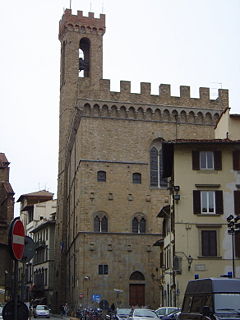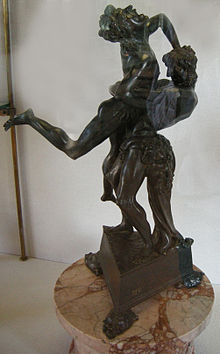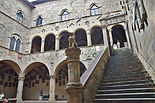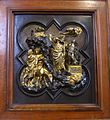Bargello


The Bargello, also known as the Palazzo del Bargello, Museo Nazionale del Bargello, or Palazzo del Popolo (Palace of the People), is a former barracks and prison, now an art museum, in Florence, Italy.
Terminology
The word bargello appears to come from the late Latin bargillus (from Goth bargi and German burg), meaning "castle" or "fortified tower". During the Italian Middle Ages it was the name given to a military captain in charge of keeping peace and justice (hence "Captain of justice") during riots and uproars. In Florence he was usually hired from a foreign city to prevent any appearance of favoritism on the part of the Captain. The position could be compared with that of a current Chief of police. The name Bargello was extended to the building which was the office of the captain.
The palace


Construction began in 1255. The palace was built to house first the Capitano del Popolo and later, in 1261, the 'podestà', the highest magistrate of the Florence City Council. This Palazzo del Podestà, as it was originally called, is the oldest public building in Florence. This austere crenellated building served as model for the construction of the Palazzo Vecchio. In 1574, the Medici dispensed with the function of the Podestà and housed the bargello, the police chief of Florence, in this building, hence its name.[1] It was employed as a prison; executions took place in the Bargello's yard until they were abolished by Grand Duke Peter Leopold in 1786, but it remained the headquarters of the Florentine police until 1859. When Leopold II, Holy Roman Emperor Peter Leopold was exiled, the makeshift Governor of Tuscany decided that the Bargello should no longer be a jail, and it then became a national museum.
The original two-story structure was built alongside the Volognana Tower in 1256. The third story, which can be identified by the smaller blocks used to construct it, was added after the fire of 1323. The building is designed around an open courtyard with an external staircase leading to the second floor. An open well is found in the center of the courtyard.[1]
The Bargello opened as a national museum (Museo Nazionale del Bargello) in 1865,[1] displaying the largest Italian collection of gothic and Renaissance sculptures (14–17th century).
Art collection
The museum houses masterpieces by Michelangelo, such as his Bacchus, Pitti Tondo (or Madonna and Child), Brutus and David-Apollo.[2] Its collection includes Donatello's David and St. George Tabernacle[3] , Vincenzo Gemito's Pescatore ("fisherboy"),[4] Jacopo Sansovino's Bacchus,[2] Giambologna's Architecture[5] and his Mercury[2] and many works from the Della Robbia family.[3][6][7][8] Benvenuto Cellini is represented with his bronze bust of Cosimo I.[2] There are a few works from the Baroque period, notably Gianlorenzo Bernini's 1636-7 Bust of Costanza Bonarelli.
The museum also has a fine collection of ceramics (maiolica), textile, tapestries, ivory, silver, armours and old coins. It also features the competing designs for The Sacrifice of Isaac (Sacrificio di Isacco) that were made by Lorenzo Ghiberti[3] and Filippo Brunelleschi[3] to win the contest for the second set of doors of the Florence Baptistery (1401).
Honolulu Hale's interior courtyard, staircase, and open ceiling were modeled after the Bargello.[9]
Gallery
-
Lorenzo Ghiberti's Isaac's Sacrifice.
-
Bust, (Niccolo da Uzzano).
-
Bust of Christ, (Tullio Lombardo).
-
Bust of Pietro Melllini (Benedetto da Maiano).
-
Coronation of Ferdinand II of Aragon.
-
Musicians from program for Coronation of Ferdinand II, (Benedetto da Maiano).
-
Anghiari Battle, Giovan Francesco Rustici after Leonardo da Vinci
-
Madonna di Santa Maria Nuova-Luca della Robbia
-
Crucifix attributed to Michelangelo.
-
Empress Ariane (Byzantine).
-
St George, (Donatello).
-
David, (Donatello).
-
Bacchus, (Michelangelo).
-
Architettura, (Giambologna).
-
Il Pescatorello (small fishboy), Vincenzo Gemito
References
- ^ a b c Zucconi, Guido (1995). Florence: An Architectural Guide (November 2001 Reprint ed.). San Giovanni Lupatoto, Verona, Italy: Arsenale Editrice. p. 38. ISBN 88-7743-147-4.
- ^ a b c d "Sala di Michelangelo e della scultura del Cinquecento". Bargello National Museum. Ministry of Cultural Heritage. Archived from the original on June 6, 2006. Retrieved July 24, 2006.
{{cite web}}: Unknown parameter|deadurl=ignored (|url-status=suggested) (help) - ^ a b c d "Salone di Donatello e della Scultura del Quattrocento". Bargello National Museum. Ministry of Cultural Heritage. Archived from the original on June 6, 2006. Retrieved July 24, 2006.
{{cite web}}: Unknown parameter|deadurl=ignored (|url-status=suggested) (help) - ^ "Il Cortile". Bargello National Museum. Ministry of Cultural Heritage. Archived from the original on June 6, 2006. Retrieved July 24, 2006.
{{cite web}}: Unknown parameter|deadurl=ignored (|url-status=suggested) (help) - ^ "Verone". Bargello National Museum. Ministry of Cultural Heritage. Archived from the original on June 6, 2006. Retrieved July 24, 2006.
{{cite web}}: Unknown parameter|deadurl=ignored (|url-status=suggested) (help) - ^ "Cappella di Maria Maddalena e Sagrestia". Bargello National Museum. Ministry of Cultural Heritage. Archived from the original on June 6, 2006. Retrieved July 24, 2006.
{{cite web}}: Unknown parameter|deadurl=ignored (|url-status=suggested) (help) - ^ "Sala di Giovanni della Robbia". Bargello National Museum. Ministry of Cultural Heritage. Archived from the original on June 6, 2006. Retrieved July 24, 2006.
{{cite web}}: Unknown parameter|deadurl=ignored (|url-status=suggested) (help) - ^ "Sala di Andrea della Robbia". Bargello National Museum. Ministry of Cultural Heritage. Archived from the original on June 6, 2006. Retrieved July 24, 2006.
{{cite web}}: Unknown parameter|deadurl=ignored (|url-status=suggested) (help) - ^ "Historic Honolulu (The Capitol District)". City and County of Honolulu. October 10, 2003. Retrieved July 24, 2006.[permanent dead link]
External links
- "Bargello National Museum". Ministry of Cultural Heritage. Retrieved 14 August 2016.

















